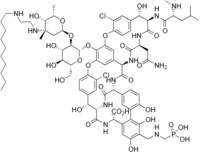Telavancin
 | |
| Clinical data | |
|---|---|
| Trade names | Vibativ |
| AHFS/Drugs.com | Monograph |
| MedlinePlus | a610004 |
| License data |
|
| Routes of administration | intravenous |
| ATC code | |
| Legal status | |
| Legal status |
|
| Pharmacokinetic data | |
| Bioavailability | N/A |
| Elimination half-life | 9 hours |
| Identifiers | |
| CAS Number | |
| PubChem CID | |
| ChemSpider | |
| UNII | |
| ChEBI | |
| ChEMBL | |
| CompTox Dashboard (EPA) | |
| ECHA InfoCard | 100.106.567 |
| Chemical and physical data | |
| Formula | C80H106Cl2N11O27P |
| Molar mass | 1755.63 g·mol−1 |
| |
| | |
Telavancin (trade name Vibativ) is a bactericidal lipoglycopeptide for use in MRSA or other Gram-positive infections. Telavancin is a semi-synthetic derivative of vancomycin.[1][2]
The FDA approved the drug in September 2009 for complicated skin and skin structure infections (cSSSI),[3] and in June 2013 for hospital-acquired and ventilator-associated bacterial pneumonia caused by Staphylococcus aureus.[4]
History
On 19 October 2007, the US Food and Drug Administration (FDA) issued an approvable letter for telavancin. Its developer, Theravance, submitted a complete response to the letter, and the FDA has assigned a Prescription Drug User Fee Act (PDUFA) target date of 21 July 2008.[5]
On 19 November 2008, an FDA antiinfective drug advisory committee concluded that they would recommend telavancin be approved by the FDA.
The FDA approved the drug on 11 September 2009 for complicated skin and skin structure infections (cSSSI).[3]
Theravance has also submitted telavancin to the FDA in a second indication, nosocomial pneumonia, sometimes referred to as hospital-acquired pneumonia, or HAP. On 30 November 2012, an FDA advisory panel endorsed approval of a once-daily formulation of telavancin for nosocomial pneumonia when other alternatives are not suitable. However, telavancin did not win the advisory committee's recommendation as first-line therapy for this indication. The committee indicated that the trial data did not prove "substantial evidence" of telavancin's safety and efficacy in hospital-acquired pneumonia, including ventilator-associated pneumonia caused by Gram-positive organisms Staphylococcus aureus and Streptococcus pneumoniae.[6] On 21 June 2013 FDA gave approval for telavancin to treat patients with hospital-acquired pneumonia, but indicated it should be used only when alternative treatments are not suitable. FDA staff had indicated telavancin has a "substantially higher risk for death" for patients with kidney problems or diabetes compared to vancomycin.[7]
Mechanism of action
Like vancomycin, telavancin inhibits bacterial cell wall synthesis by binding to the D-Ala-D-Ala terminus of the peptidoglycan in the growing cell wall (see Pharmacology and chemistry of vancomycin). In addition, it disrupts bacterial membranes by depolarization.[2][8]
Adverse effects
Telavancin has a higher rate of kidney failure than vancomycin in two clinical trials.[9] It showed teratogenic effects in animal studies.
References
- ^ Astellas, Inc. VIBATIV prescribing information, 9/2009.
- ^ a b Higgins, DL; Chang, R; Debabov, DV; Leung, J; Wu, T; Krause, KM; Sandvik, E; Hubbard, JM; Kaniga, K (2005). "Telavancin, a Multifunctional Lipoglycopeptide, Disrupts both Cell Wall Synthesis and Cell Membrane Integrity in Methicillin-Resistant Staphylococcus aureus". Antimicrobial Agents and Chemotherapy. 49 (3): 1127–1134. doi:10.1128/AAC.49.3.1127-1134.2005. PMC 549257. PMID 15728913.
- ^ a b "Theravance and Astellas Announce FDA Approval of Vibativ (telavancin) for the Treatment of Complicated Skin and Skin Structure Infections" (Press release). Theravance, Inc. and Astellas Pharma US, Inc. 2009-09-11. Retrieved 16 September 2009.
- ^ http://www.fda.gov/NewsEvents/Newsroom/PressAnnouncements/ucm358209.htm
- ^ "Drugs.com, FDA Accepts for Review Response to Approvable Letter for Telavancin". Retrieved 2008-03-08.
- ^ FDA advisory group gives mixed review of Theravance pneumonia treatment. 30 Nov 2012 American City Business Journals/San Francisco/BiotechSF blog
- ^ Leuty, Ron. Theravance gets FDA OK for antibiotic against pneumonia, with limits. San Francisco Business Times. Jun 21, 2013.
- ^ H. Spreitzer (2 February 2009). "Neue Wirkstoffe - Telavancin". Österreichische Apothekerzeitung (in German) (3/2009).
- ^ Saravolatz LD, Stein GE, Leonard B. Johnson LB. "Telavancin: a novel lipoglycopeptide". Clinical Infectious Diseases. 49 (12): 1908–1914. doi:10.1086/648438.
{{cite journal}}: CS1 maint: multiple names: authors list (link)
